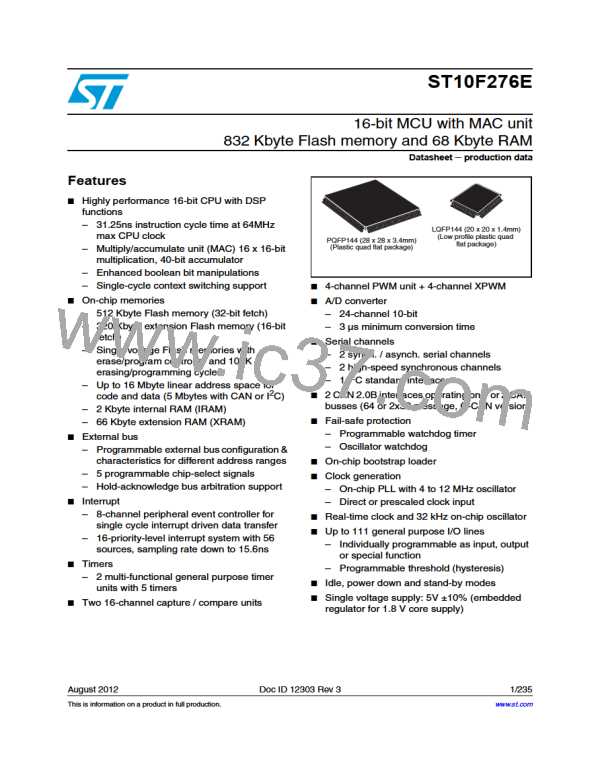System reset
ST10F276E
Synchronous reset and RPD pin
Whenever the RSTIN pin is pulled low (by external hardware or as a consequence of a
Bidirectional reset), the RPD internal weak pull-down is activated. The external capacitance
(if any) on RPD pin is slowly discharged through the internal weak pull-down. If the voltage
level on RPD pin reaches the input low threshold (around 2.5V), the reset event becomes
immediately asynchronous. In case of hardware reset (short or long) the situation goes
immediately to the one illustrated in Figure 26. There is no effect if RPD comes again above
the input threshold: the asynchronous reset is completed coherently. To grant the normal
completion of a synchronous reset, the value of the capacitance shall be big enough to
maintain the voltage on RPD pin sufficient high along the duration of the internal reset
sequence.
For a Software or Watchdog reset event, an active synchronous reset is completed
regardless of the RPD status.
It is important to highlight that the signal that makes RPD status transparent under reset is
the internal RSTF (after the noise filter).
Figure 28. Synchronous short / long hardware RESET (EA = 1)
ꢍꢇꢏ
dꢇ 4#, dꢀꢁ 4#,
ꢋ ꢀꢉꢈꢁ 4#,
234).
ꢍꢀꢏ
ꢍꢈꢏ
t ꢃꢉNS
dꢃꢉꢉNS
t ꢃꢉNS
dꢃꢉꢉNS
t ꢃꢉ NS
dꢃꢉꢉ NS
dꢀꢀ 4#,
234&
ꢍAFTER FILTERꢏ
0ꢉ;ꢀꢃꢐꢀꢈ=
.OT TRANSPARENT
.OT Tꢌ
4RANSPARENT
.OT Tꢌ
.OT Tꢌ
0ꢉ;ꢀꢁꢐꢁ=
0ꢉ;ꢀꢐꢉ=
.OT TRANSPARENT
ꢊ 4#,
)"53ꢅ#3
ꢁ)NTERNALꢉ
d ꢀMS
&,!234
ꢀꢉꢁꢇ 4#,
ꢆ 4#,
234
!T THIS TIME 234& IS SAMPLED ()'( OR ,/7
SO IT IS 3(/24 OR ,/.' RESET
234/54
20$
ꢍꢁꢏ
6
ꢔ ꢁꢌꢃ 6 ASYNCHRONOUS RESET NOT ENTERED
'!0'2)ꢉꢉꢀꢉꢃ
20$
ꢁꢉꢉ ! DISCHARGE
1. RSTIN assertion can be released there. Refer also to Section 19.1 for details on minimum pulse duration.
2. If during the reset condition (RSTIN low), RPD voltage drops below the threshold voltage (about 2.5V for
114/235
Doc ID 12303 Rev 3

 STMICROELECTRONICS [ ST ]
STMICROELECTRONICS [ ST ]